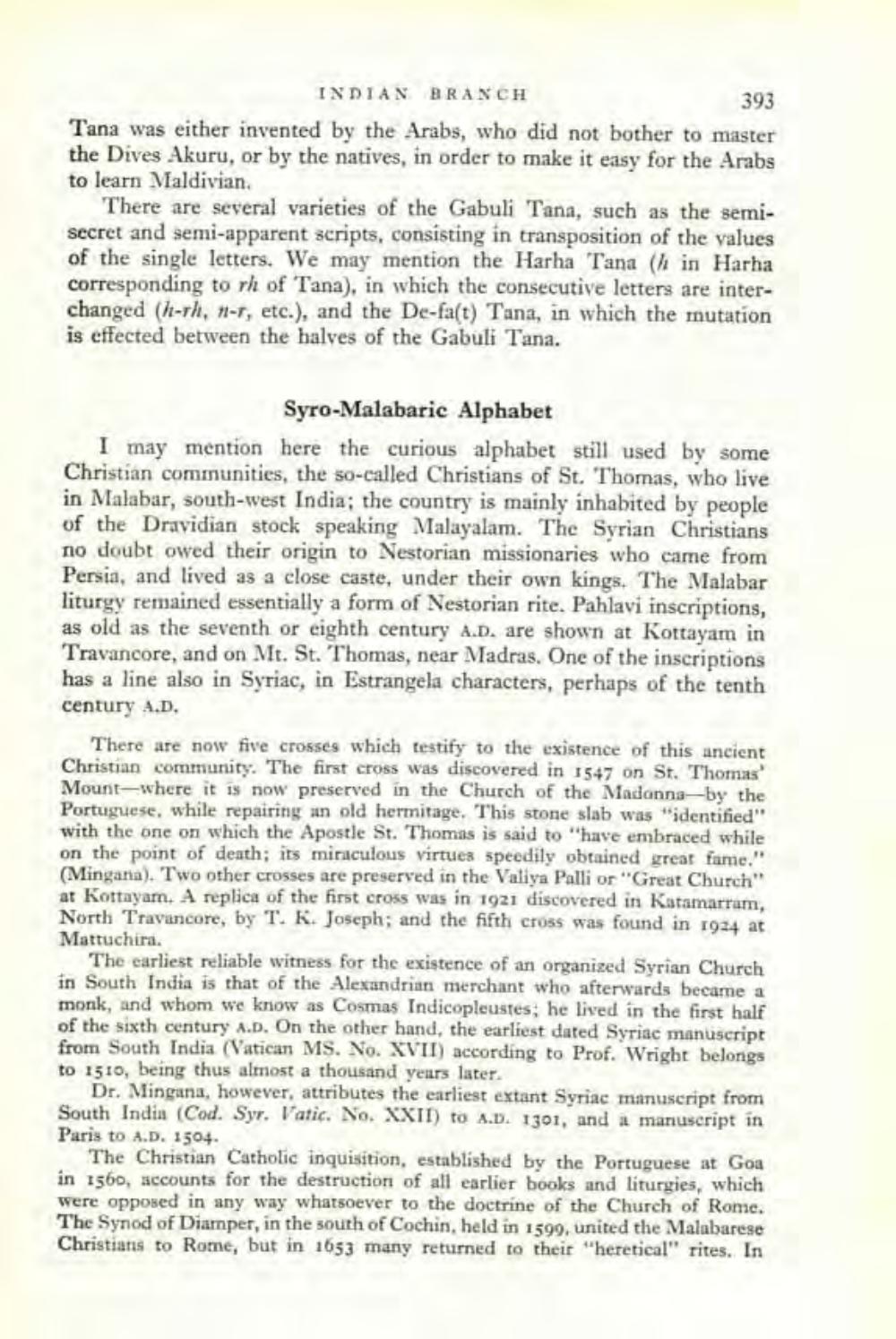________________
INDIAN BRANCH
393 Tana was either invented by the Arabs, who did not bother to master the Dives Akuru, or by the natives, in order to make it easy for the Arabs to learn Valdivian.
There are several varieties of the Gabuli Tana, such as the semisecret and semi-apparent scripts, consisting in transposition of the values of the single letters. We may mention the Harha Tana (1 in Harha corresponding to rh of Tana), in which the consecutive letters are interchanged (h-th, 1-1, etc.), and the De-fa(t) Tanz, in which the mutation is effected between the halves of the Gabuli Tana.
Syro-Malabaric Alphabet I may mention here the curious alphabet still used by some Christian communities, the so-called Christians of St. Thomas, who live in Malabar, south-west India; the country is mainly inhabited by people of the Dravidian stock speaking Malayalam. The Syrian Christians no doubt owed their origin to Nestorian missionaries who came from Persia, and lived as a close caste, under their own kings. The Malabar liturgy remained essentially a form of Nestorian rite. Pahlavi inscriptions, as old as the seventh or eighth century A.D. are shown at Kottayam in Travancore, and on Mt. St. Thomas, near Madras. One of the inscriptions has a line also in Syriac, in Estrangela characters, perhaps of the tenth century A.D.
There are now five crosses which testify to the existence of this ancient Christian community. The first cross was discovered in 1547 on St. Thomas' Mount-where it is now preserved in the Church of the Madonna-by the Portuguese, while repairing an old hermitage. This stone slab was "identified with the one on which the Apostle St. Thomas is said to "have embraced while on the point of death; its miraculous virtues speedily obtained great fame." (Mingana). Two other crosses are preserved in the Valiya Palli or "Great Church at Kottayam. A replica of the first cross was in 1921 discovered in Katamarram, North Travancore, by T. K. Joseph; and the fifth cross was found in 1924 at Mattuchira.
The earliest reliable witness for the existence of an organized Syrian Church in South India is that of the Alexandrian merchant who afterwards became a monk, and whom we know as Cosmas Indicopleustes; he lived in the first half of the sixth century A.D. On the other hand, the earliest dated Syriac manuscript from South India (Vatican MS. No. XVII) according to Prof. Wright belongs to 1510, being thus almost a thousand years later.
Dr. Mingana, however, attributes the earliest extant Syriac manuscript from South India (Cod. Syr. Vatic. No. XXII) to .. 1301, and a manuscript in Paris to A.D. 1504.
The Christian Catholic inquisition, established by the Portuguese at Goa in 1560, accounts for the destruction of all earlier books and liturgies, which were opposed in any way whatsoever to the doctrine of the Church of Rome. The Synod of Diamper, in the south of Cochin, held in 1599, united the Malabarese Christians to Rome, but in 1653 many returned to their "heretical" rites. In




